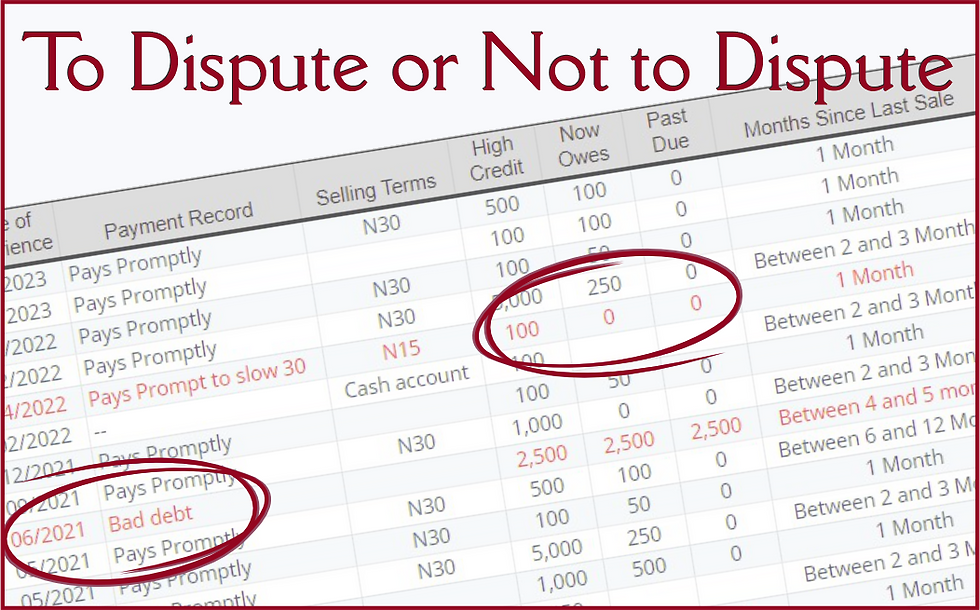How to Add Trade References to your D&B Report
- Joy Greenwood
- Mar 9, 2018
- 4 min read
Updated: Oct 13
Adding payment history to your D&B report is the fastest and easiest way to build your business credit scores and ratings. These transactions provide background information from your creditors, vendors, and suppliers that wouldn't otherwise be attributed to your file. It also adds validity, viability, and credibility to your business, sending a message to potential creditors that your company and its creditworthiness have already been proven.

Your business is a reflection of you, and your business credit report reflects your financial responsibility. Your payment history is one of the key factor that shows just how strong your business is and how capable it is at functioning on its own merit.
You need to think of your business credit profile like a skeleton. The basic information may be there, but it's not enough. You actually have to add muscle and meat to those bones in order for the company to be strong. This is especially important if your business is less than ten years old, or if your company tends to spend more money with local stores, vendors, or suppliers, since those are the ones least likely to be auto-reporters to the major corporate credit bureaus.
Unlike consumer credit, corporate credit bureaus give you the option of adding payment history to your file using one of their paid services. I recommend the monthly version D&B's CreditBuilder service to my clients (about $150/month) because it allows me to get existing payment history added relatively quickly without the client having to opt in for a long-term service that can cost over $1,500.
Most business owners don't realize that adding just one positive payment to their credit file can boost their scores and ratings by up to 90%, so just imagine how much you can boost your company's credibility if you have 5, 10, or more payments to add! Here are actual results from three clients currently enrolled in the Powerboost program:

When determining which vendors and suppliers you want to add to your business credit profile, I suggest that you follow these tips and techniques to plot out your plan of action before investing in any credit-building process.
Tips & Techniques
If you use accounting software, run a list of all payments you've made within the past 12 months to any business or contractor, and can include recurring payments you make every month, or one-time purchases you may never need to make again.
Go through your checkbook register to see who you've paid by check or debit card. If they gave you a receipt with your business name on it, it is likely in their records, too.
Browse through your credit card statements. If they charged your business credit card, they probably have your company listed in their system. This includes major corporate suppliers, a single-owner shop, or a contractor you've hired.
Pull invoices or statements from your Payables files to see who has invoiced your company in the business name.
Stay away from point-of-sale transactions unless the receipt shows your business name.
Focus only on purchases or payments that occurred within the past 12 calendar months since D&B won't allow anything any older than that into your file.
Only consider using suppliers that you know, absolutely, without a doubt, are going to report you always pay your bill on-time.
Don't limit your search to just high-dollar amounts and major purchases. While even small payments made to reputable suppliers can have a significant impact on your scores, in most cases, payments of less than $50 are disallowed or discarded.
Banks, credit cards, utilities, insurances, and lenders are usually not allowed to be submitted, so don't waste too much time on those. If those creditors are going to report, they probably already are (so make sure the business name and address on your statement matches what's in the D&B report.)
Only U.S.-based companies can be submitted, but you should always check to see if your foreign supplier has a U.S. branch location.
Don't fall into the trap of buying vendors, faking payment history, or cross-contaminating your company's credit with false or fraudulent data.
Once your list is complete, search for your supplier in D&B's online search engine at the top of their website. If your supplier comes up in the list, they have a D&B file, and only companies/contractors/suppliers that are listed with D&B are eligible to report.
If you need help, call me — 800-918-7505 — because consultations are always free, and I may be able to provide more information to help speed along your process.
Whatever you do, don't assume your corporate credit file is going to build muscle and credibility all by itself. Just like a human body, you have to feed it and nurture it so it is healthy and strong. You have to take responsibility and control the data that impacts your scores and ratings. You don't want to wait until you absolutely NEED your credit before you start boosting it.
And if you need help, ask. I'm here to help if you need me.




Great insights in this article! A Business Information Report really helps organizations make informed decisions by providing verified data on potential partners or clients